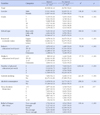Abstract
Purpose
To explore the association between sleep and the risk of accidental injury at school among Korean adolescents.
Methods
From the database of the Ninth Korea Youth Risk Behavior Web-based Survey (KYRBS), the researcher selected 63,307 adolescents who responded to a survey on sleep hours. We conducted logistic regression with sleep duration and fatigue after sleep as independent variables, the risk of injury at school as a dependent variable, and gender, grade, school type, economic status, parents' education level, number of participations in physical education, and current smoking and drinking as control variables.
Results
Using 9 hours of sleep as the reference, the adjusted injury risk (odds ratio) was 1.74 for those sleeping less than 5 hours a day, 1.61 for 5 hours, 1.45 for 6 hours, 1.31 for 7 hours, 1.13 for 8 hours, and 1.40 for 10 hours or longer. The difference between each pair of groups was statistically significant. In this study, injury risk increased as sleep duration decreased and fatigue after sleep increased.
Figures and Tables
Table 1
Unintentional Injury at School according to Sleep and Other Variables among Adolescents in Korea (N=63,307)

Table 2
Logistic Regression Analysis of Relationship between Sleep hours, Relief of Fatigue after Sleep and Injury Risk

References
1. Ministry of Education, Ministry of Health and Welfare, Korea Centers for Disease Control and Prevention. Adolescent of seven to nine among ten is lack of sleep-the seventh Korea youth risk behavior web-based survey [Internet]. Osong: Ministry of Education, Ministry of Health and Welfare, Korea Centers for Disease Control and Prevention;2011. cited 2015 January 15. Available from: http://yhs.cdc.go.kr/.
2. National Sleep Foundation. How much sleep do we really need? [Internet]. Arlington: National Sleep Foundation;cited 2015 January 15. Available from: http://sleepfoundation.org/how-sleep-works/how-much-sleep-do-we-really-need.
3. Nam SO. Normal sleep in children and adolescents. J Korean Child Neurol Soc. 2011; 19(2):66–75.
4. Rhie S, Lee S, Chae KY. Sleep patterns and school performance of Korean adolescents assessed using a Korean version of the pediatric daytime sleepiness scale. Korean J Pediatr. 2011; 54(1):29–35. DOI: 10.3345/kjp.2011.54.1.29.

5. Goel N, Rao H, Durmer JS, Dinges DF. Neurocognitive consequences of sleep deprivation. Semin Neurol. 2009; 29(4):320–339. DOI: 10.1055/s-0029-1237117.

6. Park S. Association between short sleep duration and obesity among South Korean adolescents. West J Nurs Res. 2011; 33(2):207–223. DOI: 10.1177/0193945910371317.

7. Rhie SK, Chae KY. Impact of sleep duration on emotional status in adolescents. J Depress Anxiety. 2013; 2(138):1–5. DOI: 10.4172/2167-1044.1000138.

8. Kim YY, Kim UN, Lee JS, Park JH. The effect of sleep duration on the risk of unintentional injury in Korean adults. J Prev Med Public Health. 2014; 47(3):150–157. DOI: 10.3961/jpmph.2014.47.3.150.

9. School Safety and Insurance Federation. 2013 accidents and compensation statistics. [Internet]. Seoul: School Safety and Insurance Federation;2014. cited 2015 January 15. Available from: http://www.ssif.or.kr/06_participation/part05.html.
10. Malta DC, do Prado RR, Caribe SS, da Silva MM, de Andreazzi MA, da Silva JB Júnior, et al. Factors associated with injuries in adolescents, from the National Adolescent School-based Health Survey(PeNSE 2012). Rev Bras Epidemiol. 2014; 17:Suppl 1. 183–202. DOI: 10.1590/1809-4503201400050015.
11. Mattila V, Parkkari J, Kannus P, Rimpelä A. Occurrence and risk factors of unintentional injuries among 12-to 18-year-old Finns-a survey of 8219 adolescents. Eur J Epidemiol. 2004; 19(5):437–444. DOI: 10.1023/B:EJEP.0000027355.85493.cb.
12. Stallones L, Beseler C, Chen P. Sleep patterns and risk of injury among adolescent farm residents. Am J Prev Med. 2006; 30(4):300–304. DOI: 10.1016/j.amepre.2005.11.010.

13. Lam LT, Yang L. Short duration of sleep and unintentional injuries among adolescents in China. Am J Epidemiol. 2007; 166(9):1053–1058. DOI: 10.1093/aje/kwm175.

15. Shin SM. Association of sleep habit with health behavior, experience of accident and injury treated among middle school students in seoul, Korea. Korean J Stress Res. 2015; 23(1):19–25. DOI: 10.17547/kjsr.2015.23.1.19.

16. Chen MY, Wang EK, Jeng YJ. Adequate sleep among adolescents is positively associated with health status and healthrelated behaviors. BMC Public Health. 2006; 6:59. DOI: 10.1186/1471-2458-6-59.

17. Grandner MA, Drummond SP. Who are the long sleepers? Towards an understanding of the mortality relationship. Sleep Med Rev. 2007; 11(5):341–360. DOI: 10.1016/j.smrv.2007.03.010.

18. Pilcher JJ, Ginter DR, Sadowsky B. Sleep quality versus sleep quantity: Relationships between sleep and measures of health, well-being and sleepiness in college students. J Psychosom Res. 1997; 42(6):583–596. DOI: 10.1016/S0022-3999(97)00004-4.

19. Parrott AC, Hindmarch I. The leeds sleep evaluation questionnaire in psychopharmacological investigations-a review. Psychopharmacology (Berl). 1980; 71(2):173–179.

20. Zhu H, Han Y, Sun Y, Xie Z, Qian X, Stallones L, et al. Sleeprelated factors and work-related injuries among farmers in heilongjiang province, people's republic of China. Int J Environ Res Public Health. 2014; 11(9):9446–9459. DOI: 10.3390/ijerph110909446.

21. Li Y, Jin H, Owens JA, Hu C. The association between sleep and injury among school-aged children in rural China: A case-control study. Sleep Med. 2008; 9(2):142–148. DOI: 10.1016/j.sleep.2007.01.018.

22. Boergers J, Gable CJ, Owens JA. Later school start time is associated with improved sleep and daytime functioning in adolescents. J Dev Behav Pediatr. 2014; 35(1):11–17. DOI: 10.1097/DBP.0000000000000018.

23. Owens JA, Belon K, Moss P. Impact of delaying school start time on adolescent sleep, mood, and behavior. Arch Pediatr Adolesc Med. 2010; 164(7):608–614. DOI: 10.1001/archpediatrics.2010.96.

24. Taylor DJ, Jenni O, Acebo C, Carskadon MA. Sleep tendency during extended wakefulness: Insights into adolescent sleep regulation and behavior. J Sleep Res. 2005; 14(3):239–244. DOI: 10.1111/j.1365-2869.2005.00467.x.

25. Choi YS. Jeonbuk, later school start time... I love it. but I'm still awkward [Internet]. Seoul: Yonhapnews;2014. cited 2014 October 1. Available from: http://www.yonhapnews.co.kr/bulletin/2014/10/01/0200000000AKR20141001097500055.HTML?from=search.




 PDF
PDF ePub
ePub Citation
Citation Print
Print


 XML Download
XML Download